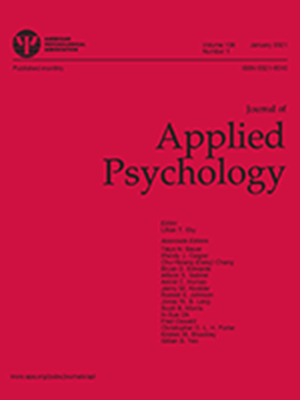解决人才选择中的多样性-效度困境:揭示多重惩罚优化回归在不同测试场景下的影响。
IF 6.1
1区 心理学
Q1 MANAGEMENT
引用次数: 0
摘要
长期以来,研究人员和从业人员一直在努力平衡选择高绩效和多样化劳动力的目标。最近,Rottman等人(2023)提出了一种新的方法来实现这些目标,我们称之为多惩罚优化回归(multipenalty optimized regression, MOR)。在拟合模型时,MOR通过添加惩罚项来最小化组差异,从而扩展了脊回归。尽管MOR已显示出潜力,但仍存在未知因素,包括MOR在典型选择设置中是否始终有效,哪些条件会影响MOR的有效性,以及MOR是否与其他多目标优化方法(如帕累托-正态边界交叉(Pareto-NBI))相似。使用蒙特卡罗模拟(研究1),我们研究了MOR的有效性,并将其与传统评分方法(脊回归、普通最小二乘、单位加权)和Pareto-NBI在几个因素上进行了比较:(a)量表(和相应项目)的数量,(b)可操作性(项目或量表),(c)预测标准相关效度的大小,(d)预测子组差异的大小,(e)校准样本量,(f)校准样本中少数群体的比例。与传统方法相比,MOR经常产生与标准相关的效度相当的解决方案,但不利影响风险始终较小。Pareto-NBI和MOR在执行双重优化方面同样有效,尽管MOR在非常小的样本量(例如,N < 150)和项目级评分时更有效。Pareto-NBI也变得计算密集,有许多预测器,使MOR更适合大数据。最后,在研究2中,在六种现实生活评估情境中,与其他方法相比,MOR表现出相似的标准相关效度和更低的不良影响风险。提出了在人员选择中应用多目标优化方法的建议。(PsycInfo Database Record (c) 2025 APA,版权所有)。本文章由计算机程序翻译,如有差异,请以英文原文为准。
Addressing the diversity-validity dilemma in personnel selection: Unraveling the impact of multipenalty optimized regression in varied testing scenarios.
Researchers and practitioners have long grappled with balancing the goals of selecting a high-performing and diverse workforce. Recently, Rottman et al. (2023) proposed a new approach to address these goals, which we refer to as multipenalty optimized regression (MOR). MOR extends ridge regression by adding a penalty term that minimizes group differences when fitting the model. Although MOR has shown potential, there are unknowns, including whether MOR is consistently effective in typical selection settings, what conditions impact MOR effectiveness, and whether MOR performs similarly to other multiobjective optimization methods, such as Pareto-normal boundary intersection (Pareto-NBI). Using Monte Carlo simulations (Study 1), we investigated MOR effectiveness and compared it with traditional scoring methods (ridge regression, ordinary least squares, unit weighting) and Pareto-NBI across several factors: (a) number of scales (and corresponding items), (b) operationalization (item or scale), (c) magnitude of predictor criterion-related validity, (d) magnitude of predictor subgroup differences, (e) calibration sample size, and (f) proportion of minorities in the calibration sample. Compared with traditional methods, MOR frequently produced solutions with comparable criterion-related validity but with consistently less adverse impact risk. Pareto-NBI and MOR were similarly effective in performing dual optimization, though MOR was more effective at very small sample sizes (e.g., N < 150) with item-level scoring. Pareto-NBI also became computationally intensive with many predictors, making MOR better suited for big data. Finally, in Study 2, MOR exhibited similar criterion-related validity and lower adverse impact risk relative to other methods across six real-life assessment contexts. We provide recommendations for using multiobjective optimization methods in personnel selection. (PsycInfo Database Record (c) 2025 APA, all rights reserved).
求助全文
通过发布文献求助,成功后即可免费获取论文全文。
去求助
来源期刊

Journal of Applied Psychology
Multiple-
CiteScore
17.60
自引率
6.10%
发文量
175
期刊介绍:
The Journal of Applied Psychology® focuses on publishing original investigations that contribute new knowledge and understanding to fields of applied psychology (excluding clinical and applied experimental or human factors, which are better suited for other APA journals). The journal primarily considers empirical and theoretical investigations that enhance understanding of cognitive, motivational, affective, and behavioral psychological phenomena in work and organizational settings. These phenomena can occur at individual, group, organizational, or cultural levels, and in various work settings such as business, education, training, health, service, government, or military institutions. The journal welcomes submissions from both public and private sector organizations, for-profit or nonprofit. It publishes several types of articles, including:
1.Rigorously conducted empirical investigations that expand conceptual understanding (original investigations or meta-analyses).
2.Theory development articles and integrative conceptual reviews that synthesize literature and generate new theories on psychological phenomena to stimulate novel research.
3.Rigorously conducted qualitative research on phenomena that are challenging to capture with quantitative methods or require inductive theory building.
 求助内容:
求助内容: 应助结果提醒方式:
应助结果提醒方式:


